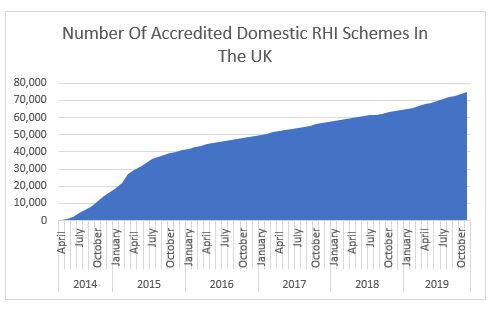What is the RHI and what can Canada learn

What can the people of Ontario/Canada learn from the UK when it comes to creating an initiative to progress the adoption of ground source heat pumps?
Incentives are a curious thing. A government can decide to subsidize a specific technology/economic sector to stimulate innovation, jobs, growth within that market. This, of course, can serve to stimulate the overall economy, as consumers take advantage of the incentives. However, without the proper controls and a defined plan in place, a well-intentioned subsidy can have some unwanted effects on an industry. Case-in-point, residential geothermal in Canada. After the cancellation of the Federal Government ecoEnergy program in 2012, the residential geothermal industry pulled back from the flurry of activity seen during the program, to settle into installation volumes well below pre-ecoEnergy levels. With this in mind, I was curious to see what was happening in the UK, as they have had a consistent program (RHI) running for a number of years now.
What Is The RHI & How Does It Work
Background
As with most developed nations, the UK has set itself decarbonization goals, specifically, a reduction in greenhouse gas emissions by 50% of 1990 levels by 2025 and 80% by 2050. This covers all sectors from power generation to vehicle emissions but one area that was given specific attention was the heating of homes and businesses.
The UK realized that a huge amount of CO2 was being produced every year just to heat occupied space. The solution to this was twofold; offer grants to improve insulation at a low cost and also to ensure that space heating was being done by environmentally friendly means.
The British government introduced the Renewable Heat Incentive (RHI) for commercial properties in 2011 followed by domestic properties in 2014 and described the policy as “the world’s first long-term financial support program for renewable heat.”
What is the RHI
The RHI is a financial payment made to a landlord (or business) every quarter if they installed a certified renewable heat system. Those who join the scheme are paid for seven years (twenty years for non-domestic) based on the amount of clean, renewable heat it is estimated their system has produced.
The payment varies based on the amount of energy the system produces and the type of system installed. For example; biomass boilers only earn £0.068 /kwh whereas ground source heat pumps (GSHP’s) earn £0.2089 /kwh.
In order to determine the amount of heat that your system is likely to produce the government looks at the Energy Performance Certificate (EPC) of the property. This includes an estimated heating requirement based on insulation and age, and calculates the amount of heat required based on general consumption across the region.
How Successful Has The RHI Been?
Since 2014 a total of almost 75,000 systems had been installed and accredited by the scheme in domestic buildings across Great Britain, with GSHP’s producing an estimated 699 GWh. That’s 16% of the total heat paid for by the RHI across all systems.
But the scheme hasn’t just been successful in improving the number of GSHP’s in operation. When looking at GSHP’s in non-domestic settings the average size of the system installed has increased as well. From 0.7 Mw in 2012, to 1.1 Mw in 2015 to 2.2 Mw in 2019.
So, What Lessons Can Canada Learn From The UK?
Make the requirements easy and clear:
There is a raft of information available produced by the UK government aimed at manufacturers and installers of GSHP systems making it easy for the industry to understand the requirements of the system. This has led to over 95% of GSHP’s applications for RHI payments being approved over the lifetime of the scheme.
Just because a system pays higher, it won't necessarily see more widespread adoption
A simple comparison of the price paid per kWh compared to the amount of heat produced by each type of system, clearly shows that just because it is more valuable does not mean that people will install it. Whilst it is true that the amounts that have been paid to each type of system have varied over the years this is by negligible amounts.
|
|
Biomass Boilers/Stoves |
Air source heat pumps |
Ground source heat pumps |
Solar thermal |
|
£/kWh produced |
6.88p |
10.71p |
20.89p |
21.09p |
|
Amount of heat paid for by RHI for each system |
49% |
33% |
16% |
1% |
One reason could be that it is much harder to retroactively fit GSHP’s compared to other systems in the UK, where the cost of retrofitting a home is significantly more expensive. For Canadian homes, the most common distribution system is a Forced Air type, which makes retrofitting GSHP’s into existing homes much easier. Another reason could be a lack of understanding of the significantly better efficiencies of GSHP’s over ASHP’s and biomass boilers.
Long Term Certainty
One of the key reasons for success for the RHI (and for many of the UK’s other green incentives) is that it was defined as a long-term solution upfront. The landlord knew that the government had made a clear, and public, commitment to pay the RHI for 7 years. This gives adopters peace of mind that they are not going to have to wait to find out, year by year, whether or not they will receive a payment. This, in turn, has increased uptake of the scheme which has created a larger number of companies that produce and install the system.
Additionally, keeping the scheme open for so many years has helped to grow the industry which will eventually be able to support itself and regulate its own manufacturing and installation costs.
Infrastructure already in place
One thing that made it easy to introduce the calculation for payment (estimated energy produced x £/kwh = £) was that the EPC certificates already included an estimated heating requirement. Under UK law these EPC certificates must be updated every three years when renting a property and are all but mandatory when selling a home. This meant that the government already had a good database of heating requirements and a pool of EPC certifiers on which it could draw.
MORE ARTICLES
HEPA Filtration District Heating - Yes, we can. Specifying Evaporative Cooling Equipment: A Quick Reference How Geothermal Works









